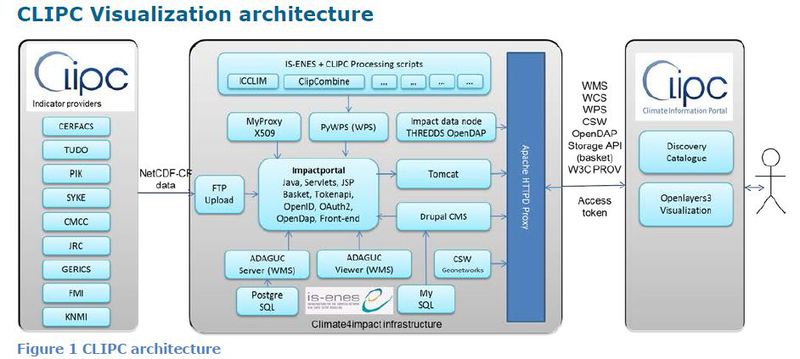D4.3 Visualisation manual
 Visualization of climateclimate
Visualization of climateclimate
Climate in a narrow sense is usually defined as the average weather, or more rigorously, as the statistical description in terms of the mean and variability of relevant quantities over a period of time ranging from months to thousands or millions of years. The classical period for averaging these variables is 30 years, as defined by the World Meteorological Organization. The relevant quantities are most often surface variables such as temperature, precipitation and wind. Climate in a wider sense is the state, including a statistical description, of the climate system. indicators is one of the essential components in the CLIPC portal. This visualization needs to be standardized and highly performant, in order to meet the user requirements.
For the CLIPC project the OGCOGC
Open Geospatial Consortium - Visit website WMSWMS
Web Mapping Service version 1.3.0 standard, implemented in ADAGUCADAGUC
Atmospheric data access for the geospatial user community. Read more on the ADAGUC Website. [3], is used for all map visualization, timeseries graphs and histograms.
ADAGUC (Atmospheric Data Access for the Geospatial User Community) is an Open Source geographical information system to visualize netCDF, HDF5 and GeoJSON over the web. ADAGUC is used because of its high performance visualization of remote OPeNDAPOPeNDAP
Open-source Project for a Network Data Access Protocol, is a data transport architecture and protocol widely used by earth scientists. The protocol is based on HTTP and the current specification is OPeNDAP 2.0 draft. OPeNDAP includes standards for encapsulating structured data, annotating the data with attributes and adding semantics that describe the data. The protocol is maintained by OPeNDAP.org, a publicly-funded non-profit organization that also provides free reference implementations of OPeNDAP servers and clients. [Source: Wikipedia] URLs, enabling fast visualization on large datasets.
For this, data needs to be standardized to enable automated visualization, styling and geographical projections. NetCDF is the required file format. These files need to comply with the CF-conventions (NetCDF-CF). As many datasets from the CLIPC community are large datasets and available in NetCDF-CF, ADAGUC is an excellent choice for implementation.
The software consists of a server side C++ application and a client side JavaScript application. Web clients like GoogleMaps, OpenLayers and Leaflet are supported and can directly use the exposed webservices.
Features of ADAGUC are: fully compliant OGC WMS and WCS, integrated data converters and post processors to support various data conventions, aggregation support.
Features developed in CLIPC context are GeoJSON polygon/vector visualization for ranking, tiling functionality for high resolutionresolution
In climate models, this term refers to the physical distance (meters or degrees) between each point on the grid used to compute the equations. Temporal resolution refers to the time step or the time elapsed between each model computation of the equations. datasets, ensembleensemble
A collection of model simulations characterizing a climate prediciton (or projection). Differences in the initial conditions and model formulations result in different evolution of the modelled systems and may give information on uncertaitny associated with model error, error in the initial conditions and with the internally generate climate variability
visualization in the CLIPC portal, histogram visualization in the CLIPC portal and the NetCDF Web Coverage Service backend.
ADAGUC is an Open Source package and can be easily installed. A fully pre-configured Virtual Machine is available and also many online tutorials are available to support developers. As such it has a growing user community, using ADAGUC in both research and operational environments.
Download the deliverable here